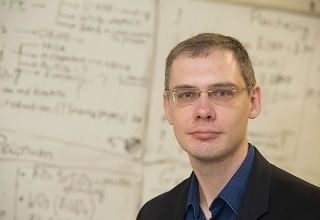Jul 10 2017
A new study claims that sulfur dioxide (SO2), a huge contributor to air pollution, can be removed from the air by concrete surfaces. Stony Brook University Researcher Alex Orlov, Ph.D. and colleagues discovered how concrete interacts and removes sulfur and nitrogen oxides. Their findings, published in the July issue of the Journal of Chemical Engineering, could be a major step toward the practice of using waste concrete to curtail air pollution.
 Alexander Orlov, PhD (credit: Stony Brook University)
Alexander Orlov, PhD (credit: Stony Brook University)
According to the World Health Organization, nearly seven million premature deaths of people around the world may be connected to pollution and poor air quality. Globally, SO2 emissions are some of the very common pollutants in the air, with power plants discharging the most SO2. Cement kilns also create around 20% of all SO2 industrial emissions.
Even though producing concrete causes air pollution, concrete buildings in urban areas can serve as a kind of sponge adsorbing sulfur dioxide to a high level. Our findings open up the possibility that waste concrete coming from building demolitions can be used to adsorb these pollutants.
Dr. Orlov, Associate Professor of Materials Science and Chemical Engineering, College of Engineering and Applied Sciences and a faculty member of the Consortium for Inter-Disciplinary Environmental Research, Stony Brook University
He added that globally concrete continues to be the most extensively used material and is inexpensive. Due to this, Dr. Orlov stressed that, “the strategy of using pollution causing material and turning it into an environmental solution could lead to new thinking in urban design and waste management.”
Dr. Orlov warned that the capacity for concrete to adsorb pollutants reduces over time as the material wears. Crushing concrete, however, can reveal new surfaces and re-establish its pollution eliminating properties.
The research team employed a variety of cement and cement-based building materials to conduct their experiments, details of which have been presented in the research paper, titled “Reactions of SO2 on hydrated cement particle system for atmospheric pollution reduction: A DRIFTS and XANES study.” They used X-ray absorption Near Edge Spectroscopy (XANES) and Diffuse Reflectance Infrared Fourier Transform Spectroscopy (DRIFTS) to identify the levels of sulfur dioxide adsorption on the materials.
Experiments were done at Stony Brook University, Brookhaven National Laboratory’s National Synchrotron Light Source and Center for Functional Nanomaterials, and the National University of Singapore.
The paper’s Co-Authors are Girish Ramakrishnan and Qiyuan Wu of Stony Brook University, and Juhyuk Moon at the National University of Singapore.
The research was supported partly by the National Science Foundation CMMI program.